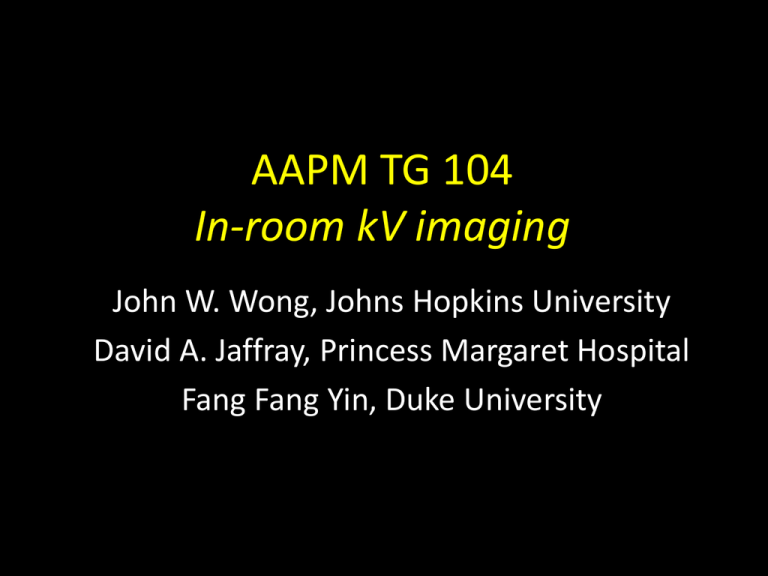AAPM TG 104 In-room kV imaging
advertisement

AAPM TG 104 In-room kV imaging John W. Wong, Johns Hopkins University David A. Jaffray, Princess Margaret Hospital Fang Fang Yin, Duke University Members • • • • • • • Fang-Fang Yin, Duke John Wong, Hopkins James Balter, UMich Stanley Benedict, UVA Jean-Pierre Bissonnette, PMH Timothy Craig, PMH Lei Dong, M.D. Anderson AAPM: Gig Mageras, Ellen York • • • • • • • • David Jaffray, PMH Steve Jiang, UCSD Siyong Kim, Mayo C-M Charlie Ma, Fox Chase Martin Murphy, VCU Peter Munro, Varian Timothy Solberg, UTSW Q. Jackie Wu, Duke Outline • Background (Wong) – Many models • Room mounted, machine mounted • Present Status (Jaffray) • Future Direction (Yin) Disclosure • John Wong receives – royalty for on-board cone beam CT imaging – research support from Elekta Acknowledgements • Physics: D Jaffray, J Siewerdsen, D Letourneau, D Yan, D Lockman, J Purdy, A Cheng, L Geer, X Ying, E Slessinger, L Pisani, D Drake • MD: A Martinez, F Vicini, J Michalski, M Graham, K Halverson, C Perez • Support: – NCI: N01-CM-97564, R01-CA41574; R01-CA42993 – Elekta-Philips (1992 – 2004) In the beginning, well …1980 • 1980 – 1990; planning – CT-based dose calculations • 1990 – 2000; delivery and uncertainty management – 3D conformal therapy (CRT) – IMRT – Adaptive RT • 2000 -- … era of IGRT – In room imaging, MV, ultrasound, kV MV verification with Electronic Portal Imaging Devices • Fast frame rate (+) • High resolution (+) • Bulky (-) • Slow acquisition (-) • Low resolution (-) • Thin footprint (+) Elekta - iView GT Varian PortalVision aS500 Issues: radiographic verification • What is the limit of setup accuracy based on bony landmark? – kV prescription; MV verification • What is the optimal PTV margin for setup? – Population (institution) vs individual – Need for repeat imaging • What is the actual dose delivered to the patient? – From 2D to 3D Absorption Unsharpness: kV vs MV 50kVp 100 kVp 6 MV Transmission (scaled to full range) Absorption Unsharpness: kV vs MV 1.0 0.8 Al 20mm 0.6 Detector (M=1.05) 6MV 0.4 100 kVp 0.2 30 keV 50 keV 2 MeV 50 kVp 0.0 -15 -10 -5 0 X Position (mm) 5 10 15 Daily vs weekly setup detection: 9 H&N patients • Need for frequent imaging What dose is delivered to the patient? Dose reconstruction with portal dose image MV Port Film Portal Dose Image CT data At time of Tx Using PDI – difference to estimate internal structural changes • Simulated 3D lungs – ρ (lung 1) = 0.2 – ρ (lung 2) = 0.3 Est’d data CT data At time of Tx Using PDI – difference to estimate internal structural changes • Failed rotation • Need more projections • kV imaging Est’d data On-board kV imaging is not new !! PMH Haynes Radiology Dual Beam kV-MV Imaging (DBI) - 1 Dual Beam kV-MV Imaging (DBI) - 2 kV vs MV projection imaging for setup Source: International Journal of Radiation Oncology * Biology * Physics 2000; 47:825-839 Copyright © 2000 Elsevier Science Inc. Terms and Conditions Daily on-line correction 14 patients: Lateral shifts kV MV On-board kV imaging experience • kV vs MV 2D setup error detection – No significant difference with rich anatomical information • kV imaging dose is low – Frequent imaging (more exposure) is possible • No information on soft tissue • Obvious !!! ---- kV CT kV conebeam CT DBI: Conebeam Acquisition, Lab Rats Coronal Sagittal DBI Conebeam Acquisition Lab Rats Voxel:1.0x0.4x0.4mm3 Matrix: 301x301x201 Imaging Parameters: 125 kVp 3.75 mAs/projection 180 projections 2o / projection Tacq=17 min Trecon = 2 hr 30 min On-board CBCT Room mounted models Digital Detector kV x-ray tube In-room tomographic system (Varian ExaCT™ at MDACC)







